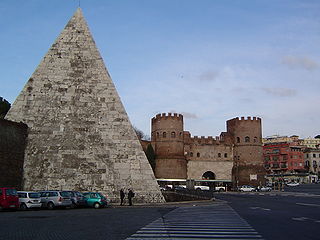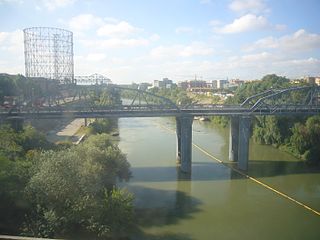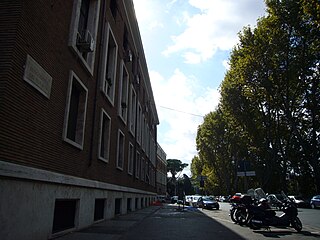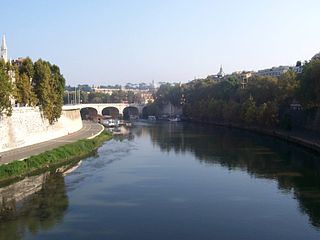
Lungotevere Testaccio is the stretch of lungotevere that connects piazza dell'Emporio with Largo Giovanni Battista Marzi (that is, between the ponte Sublicio and the ponte Testaccio), in Rome, in the Rione of the same name. [1]

Lungotevere Testaccio is the stretch of lungotevere that connects piazza dell'Emporio with Largo Giovanni Battista Marzi (that is, between the ponte Sublicio and the ponte Testaccio), in Rome, in the Rione of the same name. [1]
The Lungotevere is named after the Monte Testaccio, a relief formed in ancient times by the accumulation of debris and shards (testae in Latin) from the nearby Emporium; it was established by resolution of 20 July 1887. [2]
Below the current retaining wall there are the remains of the walls of the Emporium, which were, in the nineteenth century, excavated and paved and stripped of the marbles that had remained for centuries to under the mud of the Tiber.
To remember the excavations carried out by Pietro Ercole Visconti in this area, which allowed among other things to recover (and reuse) many ancient marbles, was erected by Pope Pius IX in 1869 a fountain made of a Roman sarcophagus used as a bath [3] on which stands the memorial inscription:
PIUS IX PONT MAX EMPORII GRADIBUS / AD TIBERIM REPERTIS / MARMORUM EX ASIAE ET AFRICAE LAPIDICINIS / INGENTI COPIA QUAE DIU LATUERAT RECUPERATA / ET SACRAE URBIS SUAE ORNAMENTO REDDITA / RIPAM HANC / IN LONG PMM IN LAT PPM / XL MURO DUCTO TERMINAVIT PUBLICAVITQUE / ANNO S.P. XXIIII
Pius IX Pontifex Maximus, found tiers of marbles of Asia and Africa at the Emporio near the Tiber in large quantities, which had remained hidden for a long time, having them retrieved and returned to adorn his sacred city, built a wall palms 2000 long and 1,040 feet wide, delimited this bank and made it public. In the XXIII year of his pontificate.
With the construction of the last section of walls on the Tiber, in the 1920s, the fountain was reassembled by inserting it in the wall towards the river. [4]

Ripa is the 12th rione of Rome, identified by the initials R. XII, and it is located in the Municipio I.

Testaccio is the 20th rione of Rome, identified by the initials R. XX, deriving its name from Monte Testaccio. It is located within the Municipio I.

Lungotevere is an alley or boulevard running along the river Tiber within the city of Rome. The building of the Lungoteveres required the demolition of the former edifices along the river banks and the construction of retaining walls called muraglioni.

The Lungotevere Maresciallo Diaz is the stretch of Lungotevere that links Piazza Lauro De Bosis to Piazzale di Ponte Milvio, in Rome (Italy), in the Quarter Della Vittoria.

Lungotevere Castello is the stretch of Lungotevere that links Piazza di Ponte Sant'Angelo to Piazza dei Tribunali, in Rome (Italy), in the rioni Borgo and Prati.

Lungotevere Gianicolense is the stretch of Lungotevere that links Piazza della Rovere to Ponte Mazzini in Rome (Italy), in the Rione Trastevere.

Via della Lungara is a street that links Via di Porta Settimiana to Piazza della Rovere in Rome (Italy), in the Rione Trastevere.

The Emporium was the river port of the ancient Rome, that rose approximately between the Aventine Hill and the Rione Testaccio.

Lungotevere degli Anguillara is the stretch of Lungotevere that links Piazza Giuseppe Gioachino Belli to Lungotevere degli Alberteschi in Rome (Italy), in the Rione Trastevere.

Lungotevere Ripa is the stretch of Lungotevere that links Ponte Palatino to the Port of Ripa Grande in Rome (Italy), in the Rione Trastevere.

Lungotevere Portuense is the stretch of Lungotevere that links Ponte Sublicio to Ponte Testaccio in Rome (Italy), in the Portuense Quarter.

Lungotevere degli Artigiani is the stretch of the lungotevere linking Ponte Testaccio to via Antonio Pacinotti, in Rome's Portuense district. The lungotevere is named after one of the guilds of the medieval Rome, that of the artisans. The avenue goes under the railway bridge of the Tyrrhenian railway, at the point where the Tiber is crossed by the bridge of Industry.

Lungotevere dei Pierleoni is the stretch of lungotevere which links piazza di Monte Savello to ponte Palatino, in Rome, in rione Ripa.

Lungotevere Marzio is the stretch of lungotevere in Rome, Italy, that connects Piazza di Ponte Umberto I with Piazza del Porto di Ripetta, in the rioni Campo Marzio and Ponte.

Lungotevere Aventino is the part of the lungotevere connecting the ponte Palatino to Piazza dell'Emporio, in Rome, in the rione Ripa.
Lungotevere Dante is the stretch of lungotevere linking Viale Guglielmo Marconi with Ponte Marconi, in Rome, in the Ostiense district.

Lungotevere delle Navi is the stretch of lungotevere linking Ponte Giacomo Matteotti to Piazzale delle Belle Arti in Rome, in the Flaminio district.
Lungotevere della Magliana is the stretch of the urban road along the Tiber that connects via del Ponte della Magliana to via della Magliana, in Rome's Portuense district.

Lungotevere Tor di Nona is the stretch of Lungotevere that connects Piazza di Ponte Sant'Angelo to Piazza di Ponte Umberto I in Rome, in the rione Ponte. It was named so following the resolution of the city council of 20 July 1887.

The following outline is provided as an overview of and topical guide to Rome: